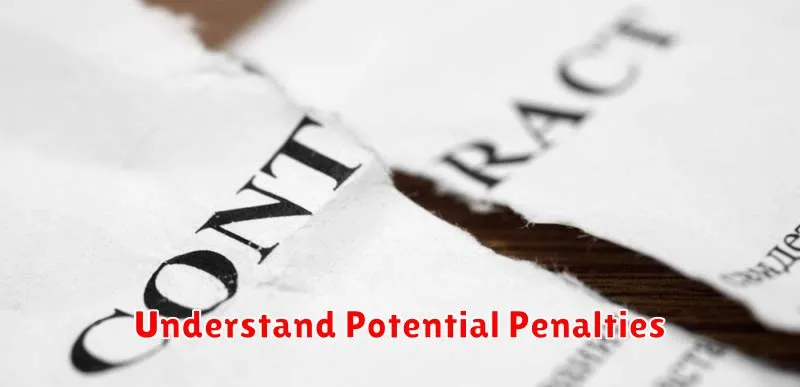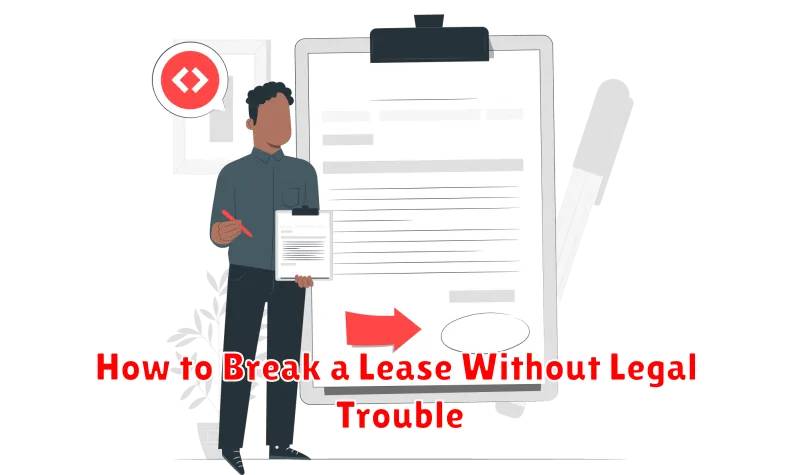Breaking a lease can be a complex and stressful situation. Many renters find themselves needing to move out before their lease term ends due to unforeseen circumstances such as job relocation, family emergencies, or even unsuitable living conditions. However, prematurely terminating a lease can lead to significant legal and financial repercussions if not handled correctly. This article provides a comprehensive guide on how to break a lease without legal trouble, outlining the necessary steps to take and the potential pitfalls to avoid. Understanding your rights and responsibilities as a tenant is crucial to navigating this process successfully. By following the advice presented here, you can minimize the risks and achieve a smooth transition out of your current lease agreement.
Learning how to break a lease legally and effectively is essential to protect yourself from potential lawsuits and financial hardship. We will cover various strategies, including reviewing your lease agreement for early termination clauses, negotiating with your landlord for an agreed-upon exit strategy, and exploring options such as finding a qualified replacement tenant. Additionally, we will discuss the legal implications of breaking a lease, including potential penalties and how to mitigate them. By understanding the proper procedures and taking proactive steps, you can successfully navigate the complexities of breaking a lease while minimizing legal trouble and preserving your financial well-being.
Know the Terms of Your Lease
Before attempting to break your lease, thoroughly review the document. Understanding the terms and conditions is crucial. Pay close attention to clauses related to early termination.
Identify any specific circumstances where breaking the lease is permitted without penalty. This might include military deployment, job relocation, or issues with the property’s habitability. Note any required notification periods or procedures outlined in your lease.
Look for information regarding subletting. Your lease might allow you to find a replacement tenant to take over the remainder of your lease term. Understand the conditions and processes involved in subletting, should it be an option.
Check for Early Termination Clauses
Carefully review your lease agreement for any clauses that address early termination. Some leases allow for termination under specific circumstances, such as job relocation or military deployment. These clauses typically outline specific procedures you must follow, including providing written notice and potentially paying a fee.
Look for specific language related to early termination options. Common terms include “early termination,” “buyout clause,” or “lease break.” Understand the conditions and costs associated with invoking these clauses, which may involve paying a percentage of the remaining rent or finding a qualified replacement tenant.
Provide Proper Notice
Providing proper notice is crucial to avoid legal repercussions when breaking a lease. Your lease agreement specifies the required notice period, typically 30 or 60 days. Delivering notice in writing is essential, providing a clear record of your intent.
Carefully review your lease for specific instructions regarding notice delivery. Some leases may require certified mail or hand delivery to a specific address. Adhering to these stipulations ensures your notice is considered legally valid.
Document Everything
Maintaining thorough documentation is crucial throughout the lease breaking process. This record serves as evidence of your attempts to mitigate damages and adhere to the terms of your lease.
Essential documents to retain include:
- A copy of your signed lease agreement
- All communication with your landlord (written and electronic)
- Records of any attempts to find a suitable replacement tenant
- Proof of any payments made towards rent or associated fees
- Any documentation related to reasons for breaking the lease (e.g., job relocation, military orders)
Organized documentation strengthens your position and provides a clear timeline of events should legal issues arise.
Negotiate with Your Landlord

Often, the simplest way to break a lease without penalty is to negotiate with your landlord. Explain your reasons for needing to leave early and be prepared to offer solutions. This demonstrates good faith and can lead to a mutually agreeable arrangement.
Consider offering to help find a suitable replacement tenant. This can alleviate your landlord’s concern about lost income. You could also propose covering advertising costs or even offer a portion of the rent for the remaining lease term, depending on your circumstances.
Sublet If Allowed
Check your lease agreement carefully for a subletting clause. Some leases explicitly prohibit subletting, while others may allow it with the landlord’s written consent. If subletting is permitted, understand the specific conditions outlined in the lease, such as required approvals or procedures.
If your lease allows subletting, find a responsible subtenant to take over your lease obligations for the remaining term. Ensure they meet the landlord’s requirements, if any. You’ll remain responsible for the lease terms if the subtenant fails to uphold their obligations. Document the sublease agreement thoroughly to outline responsibilities and protect yourself.
Use Legal Loopholes If Applicable
While less common, your lease agreement might contain specific clauses that allow for breaking the lease without penalty. Carefully review your lease for any mention of:
- Military deployment clauses: These allow active-duty military members to break a lease due to deployment orders.
- Domestic violence clauses: These offer protection for victims of domestic violence, allowing them to terminate the lease early.
- Early termination clauses: Some leases stipulate conditions under which you can terminate the lease, often with a predetermined fee.
If such a clause exists and your situation qualifies, follow the specific procedures outlined in the lease to invoke the clause and protect yourself legally. If the language is unclear, seek legal counsel to interpret the clause and ensure proper execution.
Avoid Abandoning the Property
Abandoning the property might seem like a simple solution, but it can lead to serious legal and financial repercussions. Landlords have a legal right to pursue you for unpaid rent and other damages, even if you’re no longer living there. This can negatively impact your credit score and make it difficult to rent in the future.
Furthermore, abandoning the property can expose you to additional liability. For instance, if there’s damage to the property after you leave, you could be held responsible. It’s always best to formally communicate with your landlord and follow the proper procedures for breaking your lease.
Get Confirmation in Writing
After reaching an agreement with your landlord, secure written confirmation. This documentation serves as crucial evidence should any future disputes arise.
The written agreement should clearly outline the terms of your lease termination, including the agreed-upon move-out date, any applicable fees, and the handling of your security deposit. This written confirmation protects both you and your landlord by ensuring a clear understanding of the agreement’s terms.
Understand Potential Penalties

Breaking a lease early can lead to financial repercussions. It’s crucial to carefully review your lease agreement to understand the specific penalties outlined.
Common penalties include paying the remaining rent owed, forfeiting your security deposit, and potentially facing legal action from your landlord. Some leases stipulate a fixed early termination fee, while others may require you to pay rent until the unit is re-rented.
You should also be aware of any clauses related to mitigation, where you may be responsible for helping your landlord find a new tenant to minimize your financial burden.

